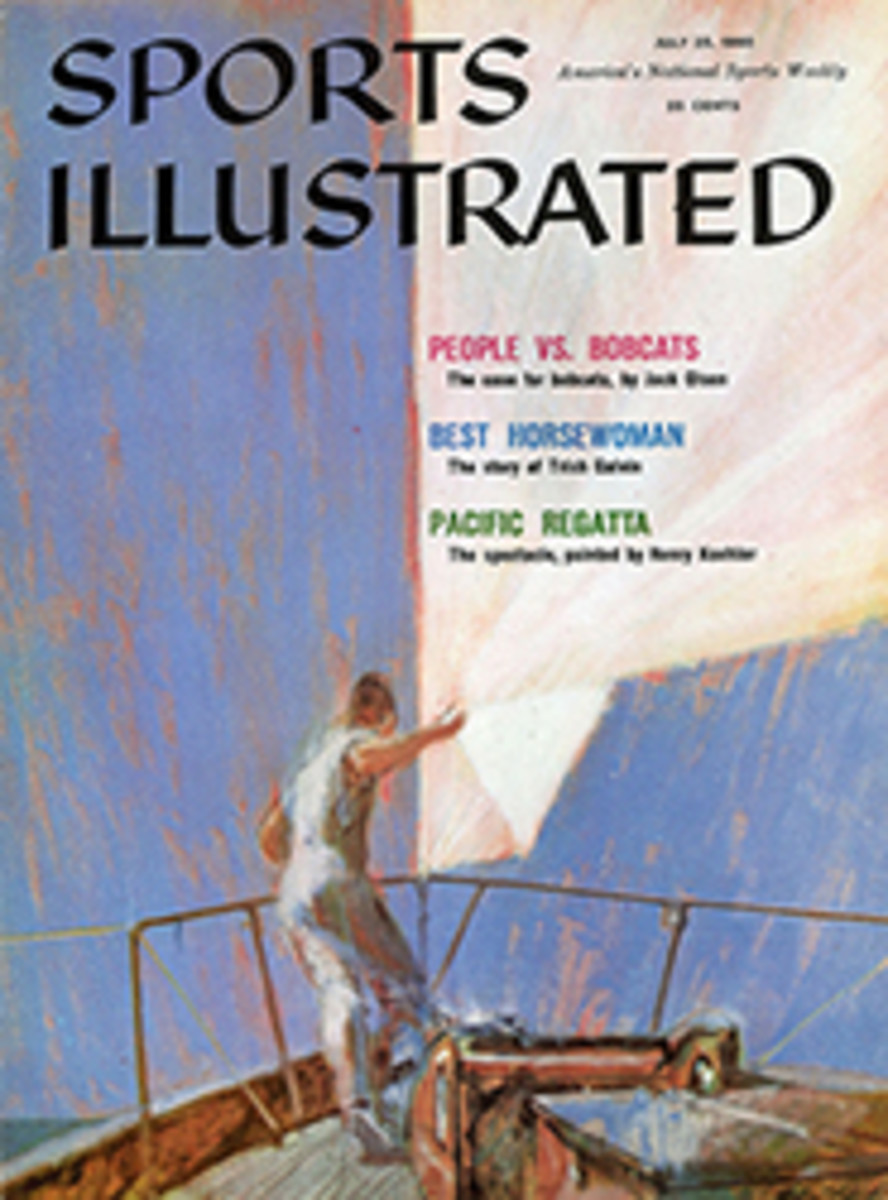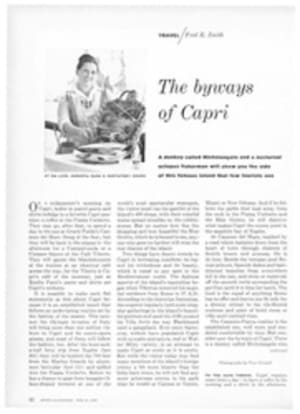
The Irishman is ready again
Two comfortably fixed men and a well-to-do horse got together in a blacksmith shop at the Good Time track in Goshen, N.Y. the other day, and the result of their meeting may conceivably affect the outcome of harness racing's richest stake races this summer, including the classic Hambletonian at DuQuoin, Ill. August 31.
One of the men was Joe O'Brien, 43-year-old driver-trainer for the S. A. Camp stables of Shafter, Calif., the leading Grand Circuit driver of 1959 and winner of purses totaling $489,404 last year. The other man was Leonard Raymond, who has been shoeing standardbreds for 35 years. Heaven only knows how much money Leonard has made in that time because race track blacksmiths have been known to gross up to $35,000 a year—and few average less than $1,500 a month.
The horse was a big handsome chestnut named Blaze Hanover, by Hoot Mon out of Beverly Hanover. Last year, Blaze won $142,052, an all-time record for 2-year-old trotters. With Lon Huber's Uncle Sam, he was a Hambletonian favorite in the winter book.
Blaze had a problem. Blaze had what is known as a quarter crack in his right front hoof which is as painful as a fingernail split down to the quick. Now this was very serious when it involved a valuable horse like Blaze, and certain circumstances made it more serious than that. Joe O'Brien and the string of 36 horses that Camp stables had sent east had had a run of bad luck this spring. A virus infection had spread through the stables, and some of Joe's best trotters and pacers were down with it. It didn't promise to be another great year like 1959. As a matter of fact, there was likely to be some red ink on the books unless Blaze Hanover could be at his best by stakes time. It was up to the big chestnut to win for the gold-and-white Camp colors this summer in just about the same way as it was for an ailing Mickey Mantle to come through for the New York Yankees.
The blacksmith had the shoe and the pad off the right front hoof now. Joe O'Brien, who had been studying the shoeing specifications for Blaze on a card out of a file box, stooped down to inspect the hoof. He stared at it for a long time and turned the old shoe over in his hands. A little group of spectators, including Esmerelda, one of the stable dogs, and an outsider from the city, moved in a little closer to inspect the injured hoof. After a minute, Joe O'Brien said, "It looks very good, it's coming along fine." With that, Leonard Raymond went to work, cleaning and paring the hoof, looking to Joe from time to time and asking for direction. Finally, the blacksmith laid the new shoe against the hoof and looked at Joe again. Joe studied it and then he said, "Take just a little more off to the right of the frog." Leonard pared off another sliver of hoof. Joe nodded, conferred with an assistant and prescribed powdered gelatin as an additive to Blaze Hanover's daily diet from then on.
The little drama in the blacksmith's shop underlined the intimate contact between horse and trainer in trotting, a relationship which does not obtain in quite the same way in Thoroughbred racing. Joe O'Brien attends the shoeing not only of ailing star performers, like Blaze Hanover, but of every horse in his stable. Among the Thoroughbreds, the blacksmith works alone, shoeing the horse with one of three standard sizes of shoes. As harness men say, the Thoroughbred people fit the foot to the shoe whereas in the world of the trotter it's the other way around: the shoe is fitted to the foot.
Because the late Sol Camp gave Joe O'Brien complete authority (as his widow and son Jim continue to do), Joe enjoys a status that is rare among trainers. He plans the breeding, he decides what horses to sell, which ones to keep, which ones to race another year, which ones to retire. He supervises every detail of training, resolves recurrent personnel problems, hires and fires. He even names the horses. Finally, he takes off his hat as many-sided executive and puts on his cap to drive as a competitor. On the day of Blaze Hanover's crucial shoeing, for instance, he got in his spanking new Cadillac and drove 60 miles to Yonkers Raceway where he won his two trotting races of the evening behind Genius and Little Rocky.
The outsider who had witnessed the operation in the blacksmith's shop was seeing Joe drive this evening for the first time. Having memorized an eloquent description of Joe's style, the outsider turned it over in his mind as Joe flashed by the stands. The expert appraisal of Joe's driving technique ran like this: "[It is] a trademark on harness tracks all over the country: the hunch of concentration, the arms immobile, the fixed tight line of the lips...a style that gives strength and dignity to the slight, slender figure of the man."
After the races, driving back to Goshen with Joe, the outsider glibly passed off the quotation as his own and, compounding the deceit, larded it with some patter picked up around the stables at the Good Time track.
The soft and gentle answer
"Joe," said the outsider, "from my observation, I've noticed that you like to keep that bit alive, you like to have your horse finish strong, no matter what his position in the race. Whereas another man might let up at the 7/8 pole when he's way back, you keep that horse on the bit, you keep that bit alive, you keep that horse brave. I conclude that you figure if you let up at the 7/8 pole when you're beaten, that same horse may quit on you at the same spot when you're winning. You almost never use the whip—except maybe to tap the rump of the horse with the butt end. While other drivers will take the reins in one hand and whip with the other, you keep the reins in both hands, and near the finish you kind of rock in the seat, urging that horse on."
Joe O'Brien is a kindly man. It takes a lot to arouse him. He's soft-spoken and gentle. He never seems to use strong language. "My goodness," he will say sometimes. Other times, he'll exclaim, "Well, I'll be durned!"
As confidently as if he were back in the race that Little Rocky had just won at Yonkers, Joe took the big car out of the lane of traffic and gunned her into a hole just ahead. The outsider waited impatiently for Joe's comment on his searching analysis of the O'Brien driving style. Finally it came, all of it. Joe said: "Never had much luck with the whip."
There wasn't much more to be said about harness racing. The outsider had exhausted his store of spurious opinions. It was a relief. The conversation turned to other things. Joe told about a skinny groom he had one time who married the fat lady in the circus. She had a baby, and they were very happy. Joe put some music on the car radio. The outsider said he didn't care what anybody said, he liked Lawrence Welk's orchestra. Joe said he did, too, and not only that: he had met the maestro personally out in California.
With the music and the talk, it was an extremely pleasant ride back to Goshen. And, taking into account the two races Joe had just won at Yonkers and the nice healing of Blaze Hanover's hoof as revealed at the blacksmith's shop that morning, it seemed reasonable to expect that Joe O'Brien might have another fine racing year after all.
PHOTO
GRAYING O'BRIEN WEARS TYPICAL TIGHT-LIPPED EXPRESSION
PHOTO
SQUATTING TO SUPERVISE FITTING OF NEW SHOE FOR BLAZE HANOVER, O'BRIEN (RIGHT) PAYS STRICT ATTENTION TO EVERY DETAIL

